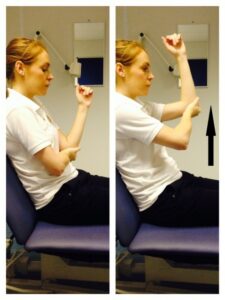This is when your shoulder comes out of joint
About your injury:
After a dislocation there is an increased risk of dislocating the shoulder again. This depends on your age and other factors. If your shoulder dislocates again, you may need to be referred to a shoulder specialist by your GP.
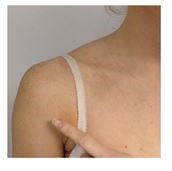
Healing:
It takes approximately 6 weeks for the soft tissues to settle.
Pain, Swelling and Pins and Needles:
Your shoulder may be swollen and you will have some pain. Taking pain medication and using ice or cold packs will help. More information is in the next section.
You may have a small patch of numbness on the outside of the shoulder. This will improve with time. Please contact us if you have any of the following symptoms:
- Pins and needles or numbness of the arm or in your hand
- If you are struggling to move the hand or arm at all
- You have pain or symptoms anywhere other than your shoulder
Wearing your sling:
Use your sling for 1 week only, including in bed at night. You can take it off to wash, dress and do your exercises.
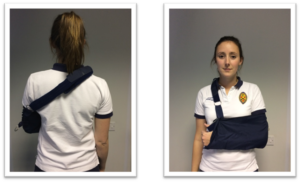
Exercise and activity:
It is important to start gentle exercises straight away to prevent stiffness. You will find pictures and instructions for your exercises below.
You should not lift the arm over shoulder height for 3 weeks or do heavy lifting for 6 weeks.
Follow up:
A follow up appointment is not normally needed for this injury. Please contact the Virtual Fracture Clinic if after 6 weeks you still have significant pain or swelling. You will be referred to our Physiotherapy Team and will be contacted by them directly.
Caring for your injury: Weeks 1-3
Wear your sling for the first week only, including in bed at night. You may find it more comfortable to sleep propped up on pillows. Remove the sling for washing, dressing and exercises.
Using a cold pack will help with your pain and swelling. You can use an ice pack or bag of frozen peas wrapped in a damp towel. Put this on your shoulder for 15 minutes every few hours. Make sure the ice isn’t in direct contact with your skin.
Try to rest your arm, especially in the first 24-72 hours. Remember to avoid overhead activity and heavy lifting.
Exercises:
Start these exercises straight away. Hand, wrist and elbow exercises are only needed while you are wearing a sling. You can stop these once they become easy and you have full movement. Try to do these exercises 4-5 times a day. Repeat each exercise 10 times.
Hand, wrist and elbow exercises:
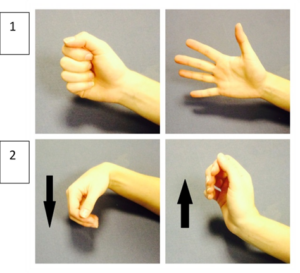
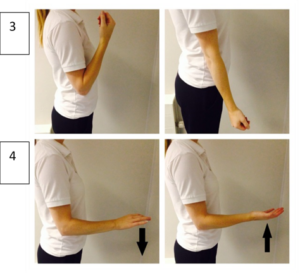
- Open and close your hand. Next, move you wrist up and down. Repeat 10 times.
- After a few days, hold a soft ball or rolled up socks. Squeeze the ball and hold for 5 seconds. Repeat 5 times.
- Bend and straighten your elbow 10 times.
- Bend your elbow to a right angle. Slowly turn your palm up to the ceiling and down to the ground. Repeat 10 times.
Posture Exercise:
Bring your shoulders back and gently squeeze your shoulder blades together. Hold for 20-30 seconds. Repeat 5 times.
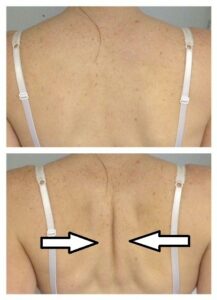
Shoulder Pendulum Exercise:
Stand next to a firm surface. Support yourself with your un-injured arm and lean forwards. Let your injured arm relax and hang down to the ground.
Gently swing your arm, making a small movement. Try to do this forward and backward, side to side and in small circles.
Aim to do this for 1-2 minutes in total. You do not need to push into pain. Remember to keep your arm relaxed.
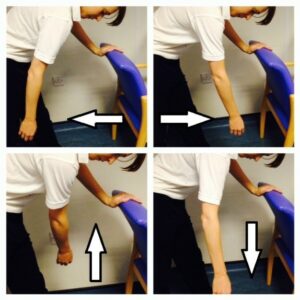
Caring for your injury: Weeks 3-6
You can now return to light activities. Gradually increase your day-to-day activity and be guided by any pain or discomfort you experience. Remember to avoid heavy lifting.
Exercises:
Start these exercises 3 weeks after your injury. Try to do them 4-5 times a day. Repeat each exercise 10 times.
Active Assisted Flexion
Use your other hand to lift your injured arm up in front of you, as shown in these pictures.
Active Assisted External Rotation
Keep the elbow of your injured arm tucked into your side and your elbow bent. Hold onto a stick, umbrella or something similar.
Use your good arm to push your injured hand outwards. Remember to keep your elbow tucked in.
If you don’t have a stick, hold your injured arm at the wrist, guide it outwards with your good hand.
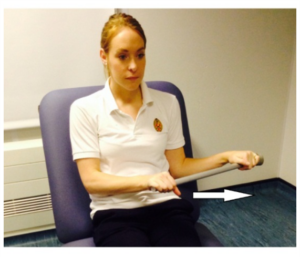
Caring for your injury: Weeks 6-12
You should be back to most of your normal activities. Take care with heavier or overhead tasks which may still be uncomfortable.
Exercises:
Start these exercises 6 weeks after your injury. Try to do these exercises 4-5 times a day. Repeat each exercise 10 times.
Active Flexion
Lift your arm forwards in front of you. Try to raise the arm as high as you can. You do not need to push into pain. If this is too difficult, try the same movement with a bent elbow.
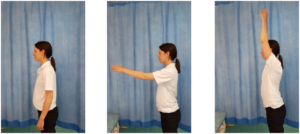
Active Abduction
With your palm facing forwards, move your arm out to the side in a big arc. Try to raise the arm as high as you can. You do not need to push into pain. If this is too difficult, try the same movement with a bent elbow.
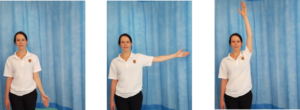
Active External Rotation
Start with your elbow bent by your side. Move your forearm out to the side, keeping your elbow bent and near your waist.
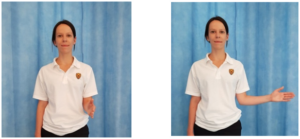
Frequently Asked Questions
I’m concerned about my symptoms and/or I am struggling to return to exercise
Please contact the Virtual Fracture Clinic.
I am struggling with my sling. What do I do?
Contact the Virtual Fracture Clinic. We can give advice or change your sling if needed.
Contact Details for Bedford and Luton
Please contact the hospital where you attended A&E as the other site will not be able to access your notes
BEDFORD HOSPITAL PATIENTS
How do I contact the Virtual Fracture Clinic (VFC)
- Telephone 01234 792036
- Messages will be checked every morning Monday to Friday (except for Bank Holidays)
- Email VFCBedford@bedfordhospital.nhs.uk
How do I contact the Fracture Clinic?
- Telephone 01234 792138
How do I contact the Plaster Room?
- Telephone 01234 792031
- Monday to Friday 9am to 5pm (out of hours contact the Emergency Department)
LUTON & DUNSTABLE HOSPITAL PATIENTS
How do I contact the Virtual Fracture Clinic (VFC)
- Telephone 01582 718121
- Messages will be checked every morning Monday to Friday (except for Bank Holidays)
- Email VFCLuton@ldh.nhs.uk
How do I contact the Fracture Clinic?
- Telephone 01582 497194 or 01582 718 993 (outpatient appointments)
How do I contact the Plaster Room?
- Telephone 01582 491166 (ext. 2233)
- Monday to Friday 9am to 5pm (out of hours contact the Emergency Department)

